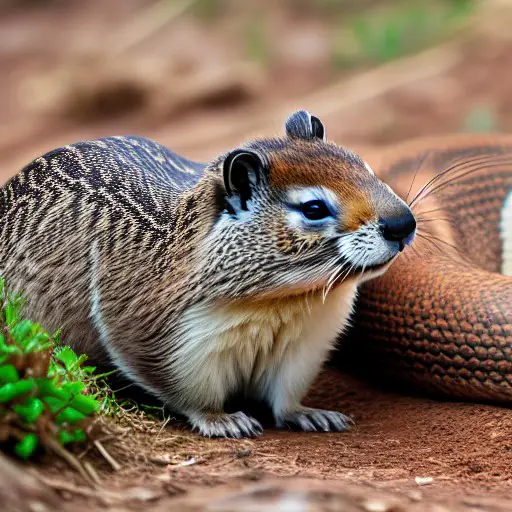Groundhogs, also known as woodchucks, are large rodents that are native to North America. They are known for their burrowing abilities, and are often found living in underground tunnels.
Groundhogs primarily consume a herbivorous diet consisting of plants, grasses, and fruits. However, they may occasionally eat small insects and grubs. It is highly unlikely for a groundhog to eat snakes, as they are not a natural part of their diet.
As herbivores, groundhogs mostly feed on vegetation like grass, clover, and dandelion leaves. However, there has been some speculation about whether or not groundhogs eat snakes.
In this blog post, we will explore this topic in-depth and answer the question: can groundhogs eat snakes?
Could a groundhog eat a snake?
Before we dive into the question of whether or not groundhogs could eat snakes, it’s important to understand their anatomy and dietary habits. Groundhogs have large, powerful jaws that are designed for gnawing on tough plant material.

They also have sharp incisor teeth that allow them to cut through roots and tough stems. Additionally, groundhogs have a digestive system that is adapted to processing plant material, with a large cecum that helps break down cellulose.
Groundhogs actual Diet
As mentioned earlier, groundhogs are herbivores and primarily feed on vegetation. They are known to consume a wide variety of plants, including:
- Grasses
- Clover
- Dandelion leaves
- Alfalfa
- Wildflowers
- Bark
- Berries
- Fruits
Groundhogs are selective feeders and will avoid plants that are toxic or unpalatable.
They also have a preference for plants that are high in protein, which is why they may occasionally consume insects or other small animals.
Groundhogs in a snake’s diet?
While groundhogs are primarily herbivores, there have been some reports of them consuming small animals like insects, snails, and even bird eggs. However, there is little evidence to suggest that groundhogs regularly eat snakes.
In fact, groundhogs are more likely to be preyed upon by snakes than the other way around.
Groundhogs are known to be preyed upon by a variety of predators, including:
- Coyotes
- Foxes
- Hawks
- Owls
- Snakes
Snakes that are known to prey on groundhogs include rattlesnakes, black rat snakes, and copperheads.
These snakes are able to ambush groundhogs in their burrows or catch them when they are out foraging for food.
Groundhog and Snake Interactions
While it is unlikely that groundhogs actively seek out snakes as prey, they may come into contact with them from time to time.
Groundhogs are known to inhabit areas where snakes are common, and may encounter them while foraging for food or moving between burrows.
In general, groundhogs will avoid snakes if possible. They are able to detect the presence of snakes through their sense of smell and will often retreat to their burrows if they sense danger.
However, if a groundhog feels threatened, it may attempt to defend itself by biting or scratching.
How To Keep Groundhogs Out Of Your Yard!
There are several things that can be done to prevent groundhogs from digging and eating stuff in your backyard. I will list some of the strategies below.
Also, see my recent post if you want a full list of my favorite methods to keep groundhogs and gophers away!
1. Using ultrasonic sound
Groundhogs, like other bigger mammals that may invade your garden, tend to have very good hearing. This means that loud or consistent noises will scare them away or at least shorten their visits.
Check out my full buying guide for these ingenious ultrasonic repeller devices here!
One of my favorite technologies to keep pests away from my backyard is these cool solar-powered ultrasonic sound emitters that you can buy right from Amazon! In my experience, they really work, and the solar panels on top save you the time and money of changing batteries all the time.
They will also work against other rodents like gophers, mice, and rats!
2. Sprinkling natural repellents
Groundhogs may be scared off by using natural scents such as coyote urine or predator scents.
They may also cause them to leave if there is a combination of sounds being played from a radio. The sounds include the sound of barking dogs and coyotes.
You can sprinkle dog hair, cayenne pepper or strong enteric oils and other natural repellents around the garden to keep the groundhogs away.
See my complete list of humane ways to keep groundhogs away from your yard for more tips and tricks!
3. Fencing around the garden
You can also fence around your garden to keep groundhogs from entering the garden. It should be at least 3 feet deep and have a double row of fencing.
Groundhogs are good diggers so it has to go underground or they may find a way into the garden even with the fences in place!
4. Using live traps
You can use a live trap to capture groundhogs and move them to another area. Live trapping is currently the most humane way of groundhog control. Once you have removed all groundhogs from an area, it is important to ensure that they do not come back by using fencing or other barriers to block access.
You can also just buy a live trap, as the sturdy metal ones shown here:
To lure the groundhogs in, you can use one of the numerous favorite foods of groundhogs or an optimized extra attractive formula like this one to make the catch even quicker!
5. Using natural pesticides
There are pesticides or rodent toxins that can be used to kill groundhogs on your property. These may also affect other animals in the area so it is important to ensure that they are only sprayed on the targeted plants.
I do not recommend these, as I prefer more humane ways as described here. Also, anything that kills an animal will also harm humans to some degree, so go for a repellant rather than a toxin if you go the chemical route!
6. Using Scarecrows
You can use a scarecrow in your garden to keep groundhogs away. Groundhogs are afraid of novelty so time-sensitive or motion-activated scarecrows may also be effective in keeping them out of the garden.
7. Using Lights
Groundhogs are not strictly nocturnal animals but they are most active at low light so they do avoid areas with bright lights.
Motion-activated lights, sounds, and sprinklers may help prevent groundhogs from entering your yard.
Any blinking light will confuse and scare away groundhogs from your yard, especially if they are motion activated and sudden!
8. Motion-activated sprinklers
Like most animals, groundhogs hate surprises, and they will run away if suddenly sprayed with water. I like this solution because it is humane, simple, effective, and does not require much time to set up.
The Havahart 5277 is a motion-activated sprinkler that is activated by the movement of animals up to 25 feet away and sprays them with a harmless water jet, frightening them off and keeping them at bay.
The included metal stake makes it easy to install in your garden, and the sprinkler can be rotated 180 degrees for maximum coverage.
## Conclusion
In conclusion, while groundhogs are primarily herbivores, they may occasionally consume small animals like insects or bird eggs.
However, there is little evidence to suggest that groundhogs regularly eat snakes.
In general, groundhogs will avoid snakes if possible, but may come into contact with them from time to time.
If you are concerned about snakes in your yard, it is important to take steps to deter them and keep your pets and family safe.















